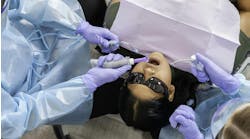By Richard H. Nagelberg, DDS
We should not be thinking of helping our patients manage their oral health from July to January or September to December. We are not practicing optimally if our focus is short term. We should be helping our patients manage their oral health for the rest of their lives, and giving them the knowledge and tools to make that a reality. The primary way for patients to make that a reality is to knock down the oral bacterial load on a daily basis. Periodontal disease is the result of the interplay between the bacteria and the host immuno-inflammatory response. Risk elements such as smoking, diabetes, xerostomia, etc. are important to control as much as possible, but since they are contributory rather than causative, the primary focus is on reducing the bacterial load. As the late Dr. Sigmund Socransky and Dr. Anne Haffajee stated in 1994, "The ultimate risk factor for an infectious disease is the causative agent of that disease. Without that agent, no disease will take place no matter what other risk factors the subject may possess." (their emphasis)
There it is -- no bacterial causative agent … no disease … period. It is that simple.
The impact of what we do as dental professionals is not limited to the space in which we operate, nor is it limited to our profession. The number of physicians who are providing bacterial DNA testing is growing as the understanding of the impact of periodontal disease and the direct effects of oral bacteria on vascular health is expanding. There are physicians, nurse practitioners, and other medical professionals who are not waiting for 50 or 500 additional studies to be completed before they act for the benefit of their patients. In the recently released book, "Beat the Heart Attack Gene," authors Bradley Bale, MD, and Amy Doneen, ARNP, state: "Today, scientific evidence that healthy gums help prevent heart attacks and strokes is so powerful that the editors of The American Journal of Cardiology and the Journal of Periodontology issued a consensus statement recommending that "Doctors and dentists warn patients with moderate to severe gum disease of their potential for cardiovascular danger." There are another three recommendations in the consensus statement. There it is. Healthy gums help prevent heart attacks and strokes. The converse is also true -- periodontal disease elevates the risk for heart attacks and strokes. It is that simple.
So, we are not just helping patients manage their oral health for the rest of their lives. We are helping them manage their overall health for the rest of their lives. Remember, maintaining or returning a patient to pristine gingival health constitutes vascular disease prevention. The details of the pathophysiology of periodontal disease and cardiovascular disease are sufficiently complex to fill a library. The basic concepts, however, are so simple. Periodontal disease increases insulin resistance; insulin resistance is the biggest root cause of atherosclerosis; and atherosclerosis is the initiator of cardiovascular events such as heart attacks and strokes. There it is again. Simple as can be.
Making it happen for every one of our patients is not complicated. Pick up an instrument with notched markings on it and stick it in every patient's mouth and record your findings. Treat disease until every site achieves health. Pick up a vial and have patients spit in it, and use the results to help develop the treatment plan. Provide an individual plan for each periodontal patient rather than a one-size-fits-all protocol. Talk to patients and explain that we are very concerned about the health of their mouths and very, very concerned about the health of their arteries.
The most important recommendations medical professionals provide for the prevention of cardiovascular disease are lifestyle recommendations, far beyond prescriptions for statins, antihypertensives, etc. Sufficiently reducing biofilm every day is our contribution to lifestyle recommendations. There it is. It is that simple.
___________________________
More by Richard Nagelberg, DDS:
___________________________








